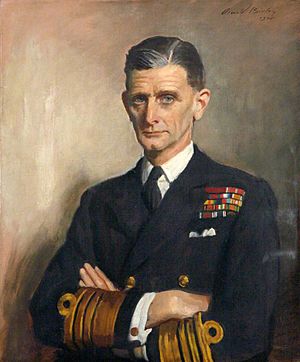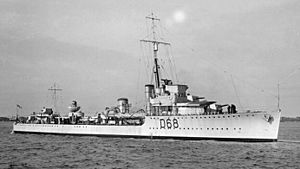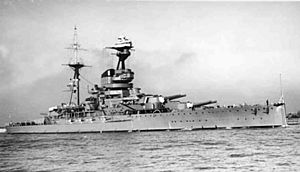Algernon Willis facts for kids
Quick facts for kids
Sir Algernon Willis
|
|
|---|---|

Willis in 1945, by Oswald Birley
|
|
| Born | 17 May 1889 Hampstead, London |
| Died | 12 April 1976 (aged 86) Royal Naval Hospital, Haslar |
| Allegiance | |
| Service/ |
|
| Years of service | 1904–1950 |
| Rank | Admiral of the Fleet |
| Commands held | HMS Wallace HMS Kent HMS Nelson HMS Vernon HMS Barham South Atlantic Station 3rd Battle Squadron Force B Force H Levant Mediterranean Fleet Portsmouth Command |
| Battles/wars | World War I World War II |
| Awards | Knight Grand Cross of the Order of the Bath Knight Commander of the Order of the British Empire Distinguished Service Order |
Admiral of the Fleet Sir Algernon Usborne Willis (born May 17, 1889 – died April 12, 1976) was a very important officer in the Royal Navy. He was known as an Admiral of the Fleet, which is the highest rank in the British Navy! He bravely served in both World War I and World War II. During these wars, he commanded many ships and led important naval operations around the world, helping to protect the seas.
Contents
Born in Hampstead, London, Algernon Willis started his naval journey at a young age. He joined the training ship HMS Britannia in 1903 when he was just 14. After his training, he became a midshipman in 1905. His first ship was the battleship HMS Hindustan. Later, he moved to the battleship HMS Glory in the Mediterranean Sea.
He quickly moved up the ranks, becoming a sub-lieutenant in 1908 and a lieutenant in 1909. He served on several ships, including the armoured cruiser HMS Donegal. In 1914, he attended a special school called HMS Vernon to learn about torpedoes.
Serving in World War I
When World War I began, Willis was a torpedo officer on the battleship HMS Magnificent. He then returned to the torpedo school HMS Vernon. Later, he served on the scout cruiser HMS Fearless. While on HMS Fearless, he took part in the famous Battle of Jutland in May 1916. This was one of the biggest naval battles in history.
After the battle, he returned to HMS Vernon and was promoted to lieutenant commander in 1917. He then joined the destroyer HMS Saumarez.
In November 1918, Willis transferred to the destroyer HMS Wallace. He saw action against the Bolsheviks in the Baltic Sea in 1919. For his bravery there, he received the Distinguished Service Order. Later that year, he joined the battlecruiser HMS Renown. On this ship, he traveled with the Prince of Wales to Australia and New Zealand.
After more training, he was promoted to commander in 1922. He became the torpedo officer on the cruiser HMS Coventry. Then, he returned to command HMS Wallace in 1927.
Rising Through the Ranks
Willis became a captain in 1929. He worked at the Royal Naval Staff College, helping to train other officers. In 1933, he became the Flag Captain (meaning he commanded the ship where the admiral's flag was flown) on the cruiser HMS Kent in China. A year later, he was Flag Captain on the battleship HMS Nelson for the Home Fleet.
He then commanded HMS Vernon again in 1935. In 1938, he took command of the battleship HMS Barham in the Mediterranean. In 1939, he became a commodore and served as Chief of Staff for the Mediterranean Fleet. This meant he was a key helper to the Commander-in-Chief, first Sir Dudley Pound and then Sir Andrew Cunningham.
Leading in World War II
When World War II started, Willis was still working with Sir Andrew Cunningham. He helped plan operations against the Italian Navy. In 1940, he was promoted to rear admiral. In 1941, he became the Commander-in-Chief, South Atlantic. In this role, he led actions against German and Japanese ships that were attacking Allied shipping.
In 1942, he became the Flag Officer commanding the 3rd Battle Squadron. He was also second-in-command of the Eastern Fleet, with his flag on the battleship HMS Resolution. In 1943, he took command of Force H. This important naval force helped cover the North African Operations, the Allied invasion of Sicily in July 1943, and the Allied invasion of Italy in September 1943. He was promoted to vice admiral in April 1943 and received another high honor, becoming a Knight Commander of the Order of the Bath.
Later in 1943, Willis became Commander-in-Chief, Levant. Here, he led naval operations in the Aegean Sea to support the Dodecanese Campaign. In 1944, he became Second Sea Lord. In this role, he was in charge of making sure there were enough sailors for the war in the Pacific Ocean against the Imperial Japanese Navy. He was promoted to full admiral in 1945. He also received awards from Greece for his service.
After the War
After World War II, Willis became Commander-in-Chief, Mediterranean Fleet in 1946. During this time, he faced challenges in Mandatory Palestine, working to keep peace in a difficult region. For his service, he was given the highest honor, becoming a Knight Grand Cross of the Order of the Bath in 1947.
In 1948, he became Commander-in-Chief, Portsmouth. This was a very important command in the UK. In 1949, he reached the highest rank possible, becoming Admiral of the Fleet. He retired from the Navy in 1950. Even after retiring, he attended the coronation of Queen Elizabeth II in 1953.
In his retirement, Sir Algernon Willis lived in Petersfield. He became a Deputy Lieutenant for Southampton and was Chairman of the Trustees for the Imperial War Museum. He passed away at the Royal Naval Hospital, Haslar on April 12, 1976.
Family
In September 1916, Willis married Olive Christine Millar. They had two daughters together.



